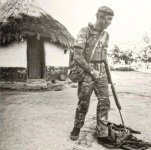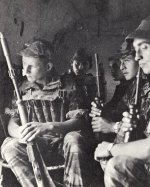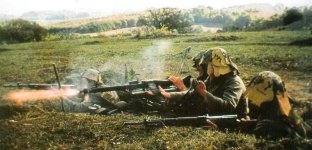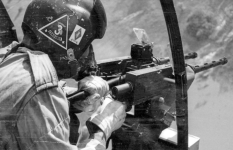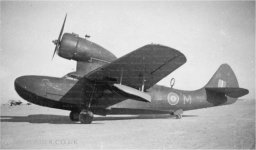fat tony
CGN Ultra frequent flyer
HMCS NIPIGON DDH 266

On 18 Oct 1965, a fire broke out aboard the ship, causing the death of three crew; no official cause for the explosion and subsequent fire has ever been given. LS Doyle Clement White and Able Seaman Wendell Tolson Gray were awarded the British Empire Medal for Gallantry for their actions that day.
B.E.M. Citation for LS Doyle White: "At approximately 2030 hours on 18th October 1965, while at sea, two explosions occurred in 12 Mess on HMCS NIPIGON. The force of these explosions blew the locked cover off a tank containing JP 5 helicopter fuel causing a flash fire in the Mess. The compartment directly above the Mess contained ammunition. At the time of the explosions there were eleven men in 12 Mess, one of which was Leading Seaman White. Although burned about the face and hands when 'escaping from the Mess, Leading Seaman White rushed to the Quartermaster's lobby to inform the lifebuoy sentry of the explosions in order that Command could be informed. He then returned to the area of the Mess to assist where needed but when advised that one man who appeared to be unconscious had not escaped from the Mess, immediately 'donned a set of breathing equipment and re-entered the Mess. The Mess at this time was filled with fumes from the JP 5 fuel and heavy black smoke. Freeing the unconscious man Leading Seaman White, with the assistance of Able Seaman Gray who had just entered, carried the man to the foot of the hatch and then searched all bunks to ensure no one else was trapped. Then - with the assistance of the Able Seaman and other crew members, brought the man up to the mortar well on the deck above. Leading Seaman White then assisted the damage control parties in flooding the JP 5 fuel tank with sea water and the removal of smouldering material. Although burned by the initial flash fire, Leading Seaman White alerted Command, re-entered the fume and smoke filled Mess to rescue a comrade, and did excellent work in a dangerous area which contained an open JP 5 fuel tank adjacent to stored ammunition before obtaining medical attention for himself. This fine display of courage in the face of serious injury or possible death, is a credit not only to Leading Seaman White, but also his ship and the Canadian Forces.
B.E.M. Citation for AB Wendell Gray: "At approximately 2030 hours on 18th October 1965, while at sea, two explosions occurred in 12 Mess on HMCS Nipigon. The force of the explosions blew the locked cover off a tank containing JP5 helicopter fuel causing a flash fire in the Mess. Directly above the Mess was a compartment containing ammunition. At the time of the explosion, Able Seaman Gray was in the main cafeteria. Immediately making his way to the upper deck, he was instructed by the Damage Control Officer to break out all available breathing equipment. When informed that LS White had entered the Mess to free an unconscious man, he quickly donned same, and following the Leading Seaman into the mess, assisted in the evacuation of the man to the mortar well on the deck above. The Mess at this time was filled with fumes from the JP5 fuel and heavy smoke. Returning to the area, AB Gray entered the Mess on three successive occasions with fire fighting and other equipment and assisted the damage control parties in clearing the Mess of the smouldering material. Although the youngest in the group, AB Gray assisted in the rescue of a comrade, entered the Mess on several occasions where there was an open JP5 fuel tank, and assisted the damage control parties with the fire-fighting and removal of smouldering materials. His actions throughout this incident, in 12 the face of serious injury or possible death, have brought credit not only to himself, but also to his ship and the Canadian Forces."
Why has this incident been hidden for so long?
There was a bad dockside incident on HMCS Protecteur that caused multiple deaths of crewmen who were asphyxiated when they entered an empty fuel tank for work. This happened in the 1970's as I recall. A very bad day for the community.
To be honest and truthful, peacetime RCN service at the sharp end throughout the entirety of the Cold War was quite dangerous, especially in the North Atlantic.
A vast storehouse of RCN history:
https://www.forposterityssake.ca/RCN.htm

On 18 Oct 1965, a fire broke out aboard the ship, causing the death of three crew; no official cause for the explosion and subsequent fire has ever been given. LS Doyle Clement White and Able Seaman Wendell Tolson Gray were awarded the British Empire Medal for Gallantry for their actions that day.
B.E.M. Citation for LS Doyle White: "At approximately 2030 hours on 18th October 1965, while at sea, two explosions occurred in 12 Mess on HMCS NIPIGON. The force of these explosions blew the locked cover off a tank containing JP 5 helicopter fuel causing a flash fire in the Mess. The compartment directly above the Mess contained ammunition. At the time of the explosions there were eleven men in 12 Mess, one of which was Leading Seaman White. Although burned about the face and hands when 'escaping from the Mess, Leading Seaman White rushed to the Quartermaster's lobby to inform the lifebuoy sentry of the explosions in order that Command could be informed. He then returned to the area of the Mess to assist where needed but when advised that one man who appeared to be unconscious had not escaped from the Mess, immediately 'donned a set of breathing equipment and re-entered the Mess. The Mess at this time was filled with fumes from the JP 5 fuel and heavy black smoke. Freeing the unconscious man Leading Seaman White, with the assistance of Able Seaman Gray who had just entered, carried the man to the foot of the hatch and then searched all bunks to ensure no one else was trapped. Then - with the assistance of the Able Seaman and other crew members, brought the man up to the mortar well on the deck above. Leading Seaman White then assisted the damage control parties in flooding the JP 5 fuel tank with sea water and the removal of smouldering material. Although burned by the initial flash fire, Leading Seaman White alerted Command, re-entered the fume and smoke filled Mess to rescue a comrade, and did excellent work in a dangerous area which contained an open JP 5 fuel tank adjacent to stored ammunition before obtaining medical attention for himself. This fine display of courage in the face of serious injury or possible death, is a credit not only to Leading Seaman White, but also his ship and the Canadian Forces.
B.E.M. Citation for AB Wendell Gray: "At approximately 2030 hours on 18th October 1965, while at sea, two explosions occurred in 12 Mess on HMCS Nipigon. The force of the explosions blew the locked cover off a tank containing JP5 helicopter fuel causing a flash fire in the Mess. Directly above the Mess was a compartment containing ammunition. At the time of the explosion, Able Seaman Gray was in the main cafeteria. Immediately making his way to the upper deck, he was instructed by the Damage Control Officer to break out all available breathing equipment. When informed that LS White had entered the Mess to free an unconscious man, he quickly donned same, and following the Leading Seaman into the mess, assisted in the evacuation of the man to the mortar well on the deck above. The Mess at this time was filled with fumes from the JP5 fuel and heavy smoke. Returning to the area, AB Gray entered the Mess on three successive occasions with fire fighting and other equipment and assisted the damage control parties in clearing the Mess of the smouldering material. Although the youngest in the group, AB Gray assisted in the rescue of a comrade, entered the Mess on several occasions where there was an open JP5 fuel tank, and assisted the damage control parties with the fire-fighting and removal of smouldering materials. His actions throughout this incident, in 12 the face of serious injury or possible death, have brought credit not only to himself, but also to his ship and the Canadian Forces."
Why has this incident been hidden for so long?
There was a bad dockside incident on HMCS Protecteur that caused multiple deaths of crewmen who were asphyxiated when they entered an empty fuel tank for work. This happened in the 1970's as I recall. A very bad day for the community.
To be honest and truthful, peacetime RCN service at the sharp end throughout the entirety of the Cold War was quite dangerous, especially in the North Atlantic.
A vast storehouse of RCN history:
https://www.forposterityssake.ca/RCN.htm
Last edited:
















































